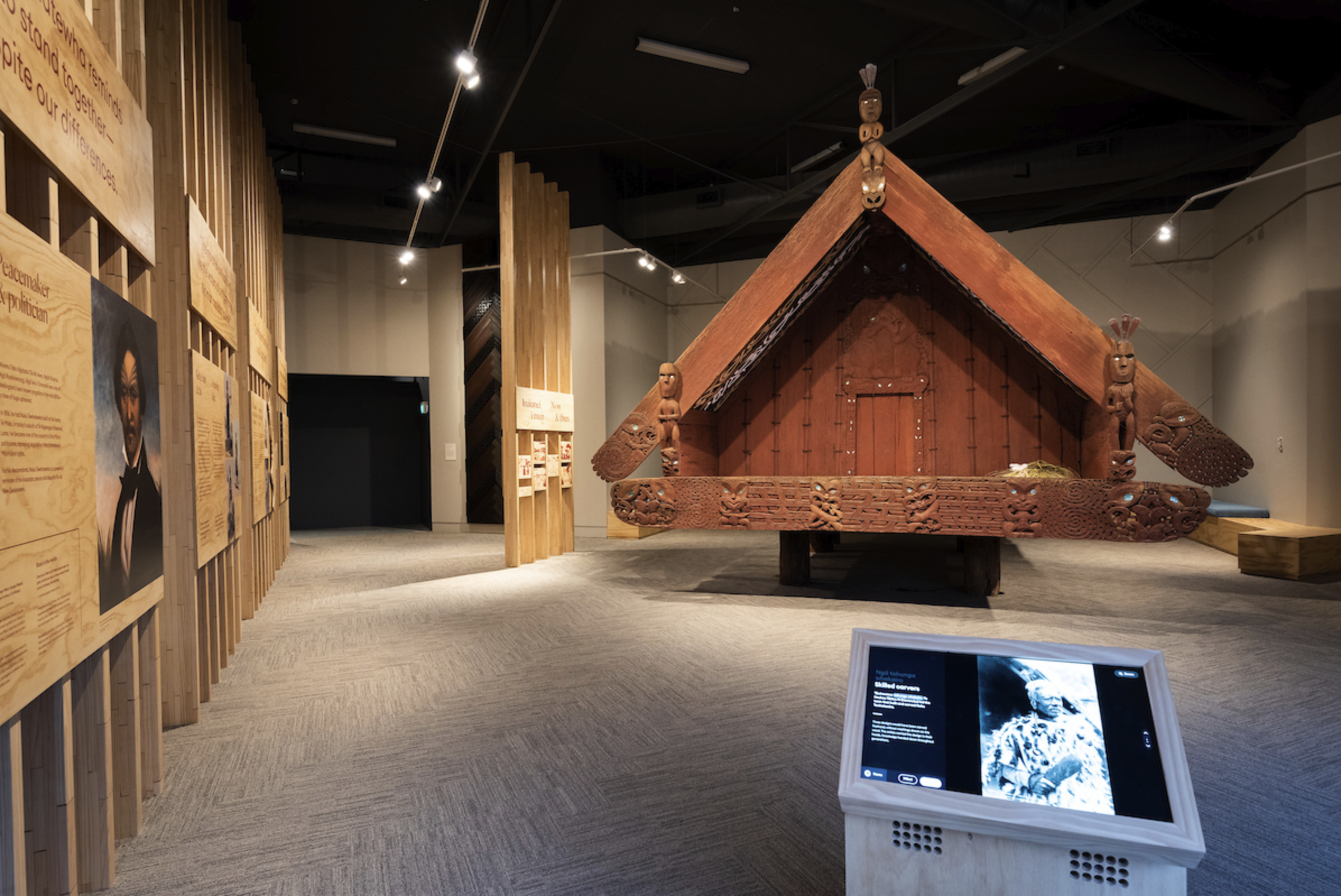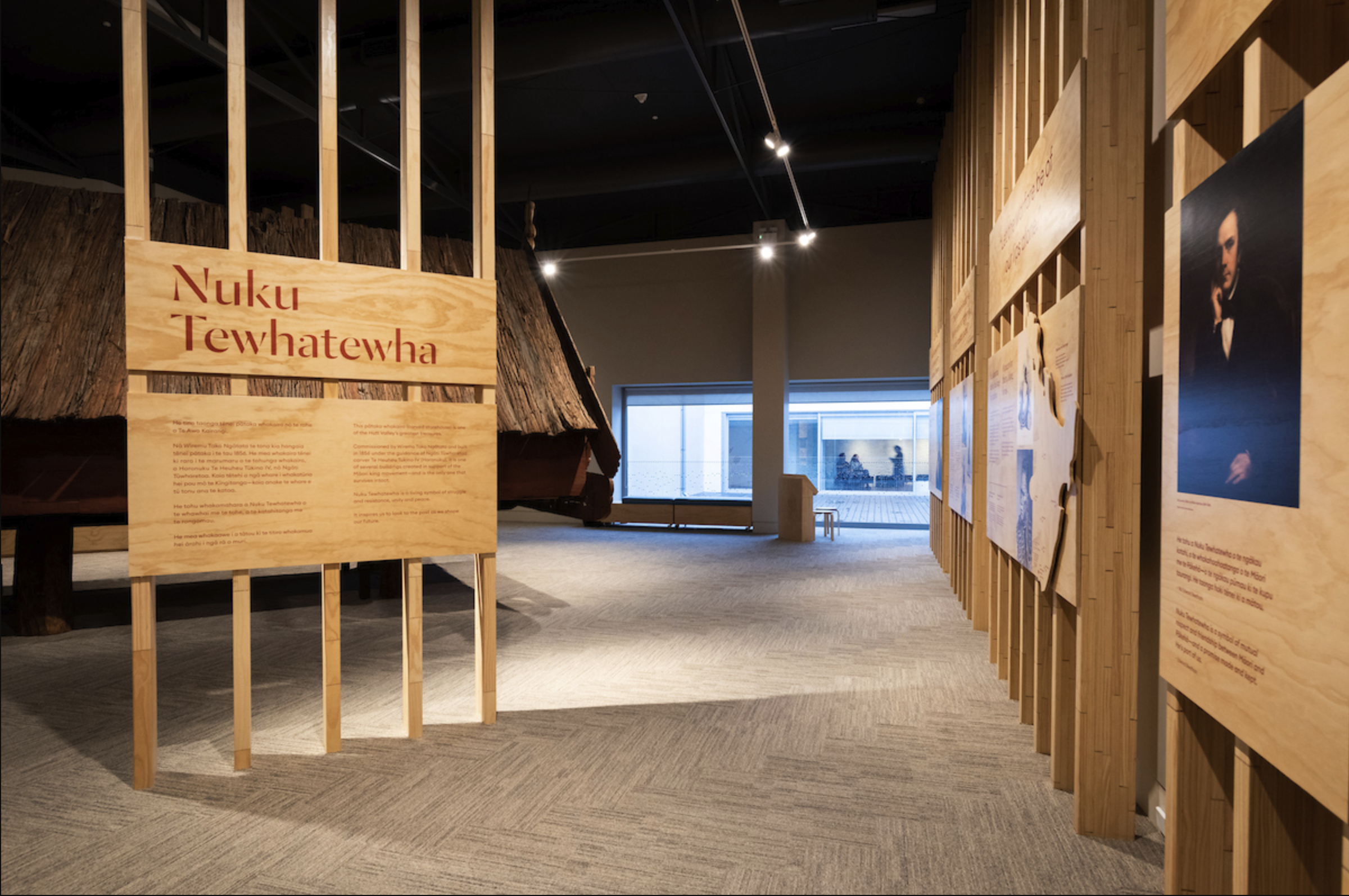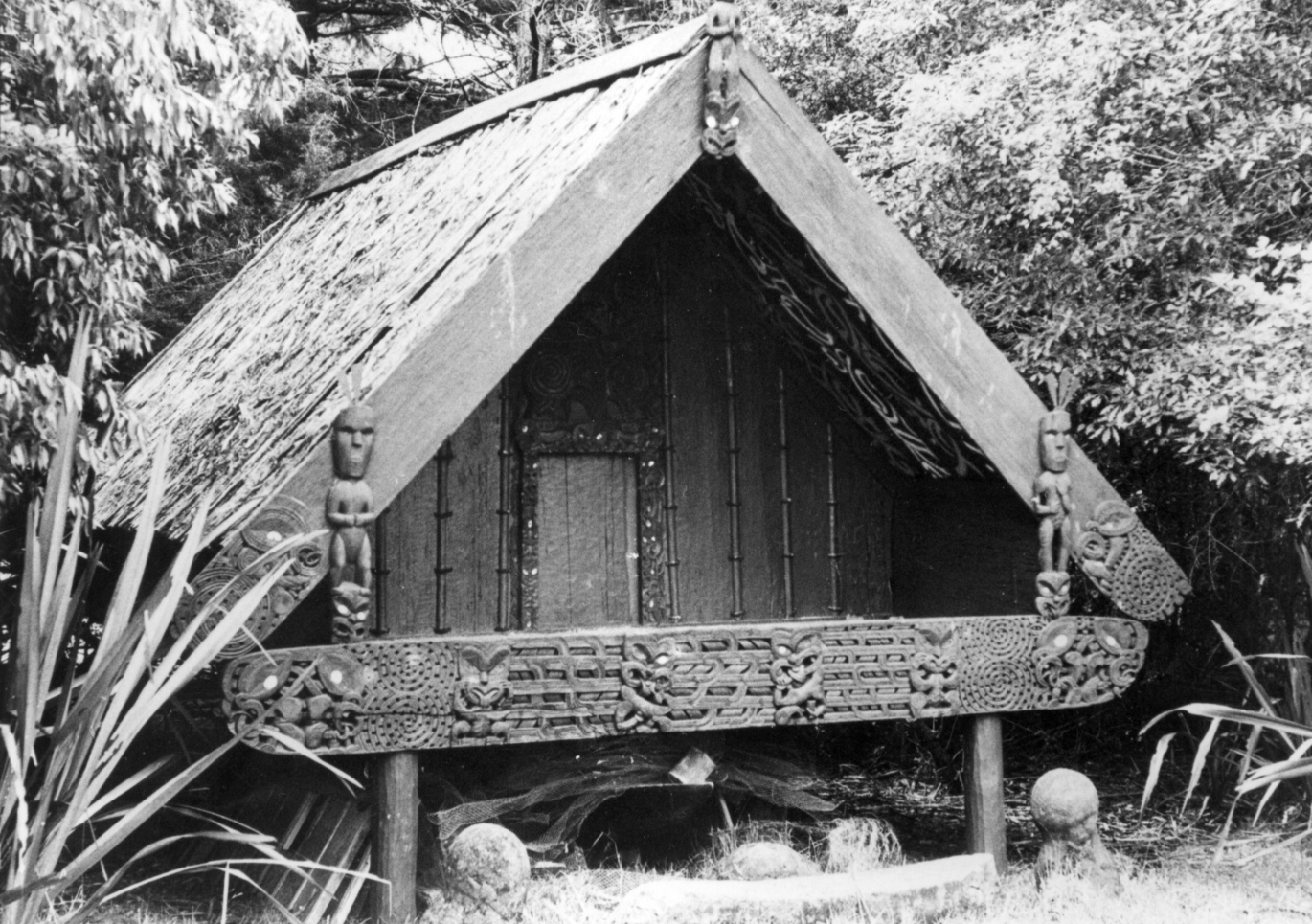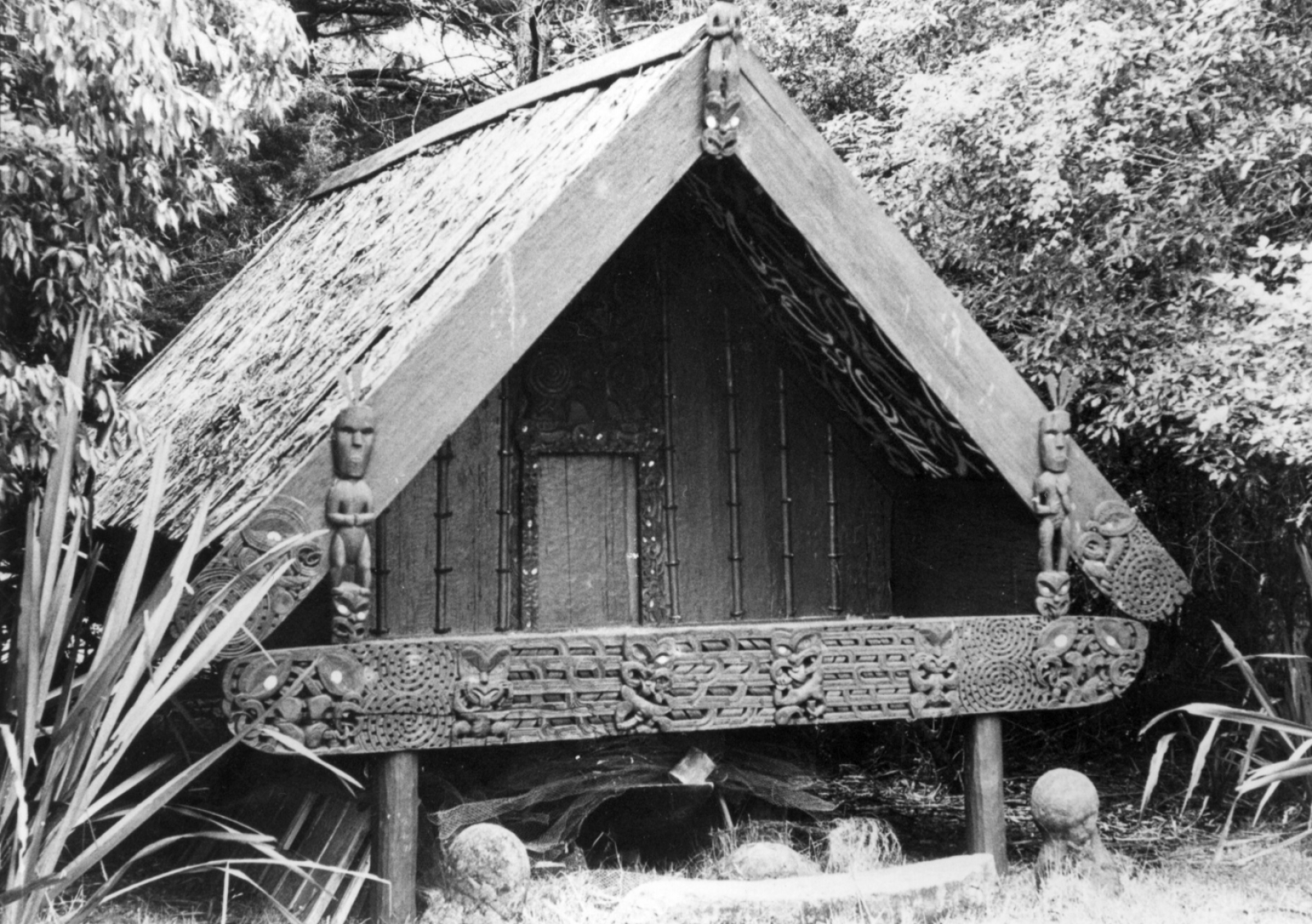
Exhibitions
This pātaka whakairo (carved storehouse) is one of the Hutt Valley’s greatest treasures.
Commissioned by Wiremu Tako Ngātata and built in 1856 under the guidance of Ngāti Tūwharetoa carver Te Heuheu Tukino IV (Horonuku), it is one of several buildings created in support of the Māori king movement—and is the only one that survives intact.
Nuku Tewhatewha is a living symbol of struggle and resistance, unity and peace.
It inspires us to look to the past as we shape our future.
He tino taonga tēnei pātaka whakairo nō te rohe o Te Awakairangi.
Nā Wiremu Tako Ngātata te tono kia hangaia tēnei pātaka i te tau 1856. He mea whakairo tēnei ki raro i te marumaru o te tohunga whakairo, o Horonuku Te Heuheu Tūkino IV, nō Ngāti Tūwharetoa. Koia tētahi o ngā whare i whakatūria hei pou mō te Kīngitanga—koia anake te whare e tū tonu ana te katoa.
He tohu whakamahara a Nuku Tewhatewha o te whawhai me te tohe, o te kotahitanga me te rongomau.
He mea whakaawe i a tātou ki te titiro whakamua hei ārahi i ngā rā o muri.
Peacemaker and politician
Wiremu Tako Ngātata (Te Āti Awa, Ngāti Ruanui, Ngā Ruahinerangi, Ngā Iwi o Taranaki)
was one of Wellington’s best known rangatira in the mid-1800s—a time of huge upheaval.
In 1856, he had Nuku Tewhatewha built at his home, Te Mako, in today’s suburb of Naenae. Later, he became one of the country’s first Māori politicians, opposing legislation that threatened Māori land rights.
For his descendants, Nuku Tewhatewha is a powerful reminder of his kaupapa: peace and equality for all New Zealanders.
Wiremu Tako Ngātata’s friend William Beetham painted this portrait, and would look after Nuku Tewhatewha in years to come.
He kaihāpai i te rongomau, he kaitōrangapū
He rangatira nui a Wiremu Tako Ngātata (nō Te Āti Awa, Ngāti Ruanui, Ngā Ruahinerangi, Ngā Iwi o Taranaki), ka hau tōna rongo ki Te Whanganui-a-Tara i waenga i te rautau 1800—i te wā o te pānga mai o ngā hurihanga nui.
I te tau 1856, nāna te tono kia whakatūria a Nuku Tewhatewha ki tōna kāinga, ki Te Mako, arā, kei te takiwā o Naenae i tēnei rā. Nō muri atu, ko ia tētahi o ngā kaitōrangapū Māori tuatahi e whakahē ana i ngā ture e tango ana i ngā whenua Māori.
Ki āna uri, ko Nuku Tewhatewha tētahi tohu whakamahara o te kaupapa nui o Wiremu Tako Ngātata, arā, kia rite tahi te noho o ngā tāngata katoa o Aotearoa, i raro i te rongomau.
Ka huri ngā tau, ka tiakina a Nuku Tewhatewha e tōna hoa, e William Beetham, nāna tēnei whakaahua kiri i peita.
Stuck in the middle
Care for our Māori and Pākehā people when I am gone, and let your voice in these matters thunder to me in Te Reinga [the heavens].
Te Āti Awa rangatira Honiana Te Puni
Throughout his life, Wiremu Tako Ngātata tried to cooperate with Pākehā while standing up for Māori. It was his older relative Te Puni’s dying instruction, and is still passed down today.
New settlers saw him as a ‘great agitator’, while some Māori accused him of cosying up to the Crown. Holding the middle ground, he was admired and condemned by both sides.
He takawaenga
I muri nei kia pai ki aku taonga Māori, taonga Pākehā, kia tae ake te haruru o tō reo ki ahau, ki Te Reinga.
Nā Honiana Te Puni, he rangatira nō Te Āti Awa
Ko te mahi nui a Wiremu Tako Ngātata i te wā i a ia, he whakapau i tōna kaha ki te mahi ngātahi ki te Pākehā, ki te tohe hoki mō ngā take a te Māori. Koia hoki te ōhākī a tōna matua, a Honiana Te Puni, ā he kōrero tuku iho tērā i tēnei rā.
Hei tā ngā Pākehā tuatahi he ‘kaiwhakaaraara matua’ ia, hei tā ētahi o ngā Māori, he kaha nōna ki te whakahoahoa atu ki te Karauna. Otirā, koia hoki te āhua o tōna tūranga hei takawaenga, he tangata e arohaina ana, e whakahēngia ana e ngā taha e rua.
A turning tide
I ask you, Pākehā, what did the Queen tell you? Did she say to you, ‘go to New Zealand and fraudulently take away the land of the natives’?
Wiremu Tako Ngātata, 1844
On September 27, 1839, Te Āti Awa rangatira signed a piece of parchment that supposedly ‘sold’ the entire Wellington region to the British-owned New Zealand Company. Wiremu Tako Ngātata was one of them.
It was soon clear they’d been duped. Wiremu Tako Ngātata and his relatives had no intention of selling—they thought they were simply giving the ship Tory anchorage rights. The deed of sale was badly translated, had no map, and was later declared invalid. But hundreds of settlers soon streamed ashore.
Surveyors forced iwi out of what is now central Wellington. Wiremu Tako Ngātata made it his life’s mission to help his people reclaim their land. Nuku Tewhatewha is a symbol of that fight, which continues today.
Kei te huri te tai
Nā te Kuini o Ingarangi koe i kī atu kia haere mai ki Niu Tīreni ki te whānako i ngā whenua o te tangata whenua?
Wiremu Tako Ngātata, i te tau 1844
I te 27 o Hepetema i te tau 1839, hei tā te kōrero, i hanaitia e ngā rangatira o Te Āti Awa tētahi pepa ‘e hoko atu ana’ i te katoa o te rohe o Te Whanganui-a-Tara ki te Kamupene o Niu Tīreni nō Piritana. Ko Wiremu Tako Ngātata tētahi o aua rangatira.
Ka kitea kua tinihangatia rātou. Kāore a Wiremu Tako Ngātata rātou ko ōna whanaunga i pīrangi ki te hoko atu i ngā whenua – tērā te pōhēhe, kua whakaae noa rātou kia tau atu te punga o te Tory ki ō rātou wai. Kāore i tika te whakamāoritanga o te kawenata, kāore hoki he mahere e tohu ana i te rohe i hokona, nō muri atu, ka kitea kāore he mana o te kawenata. Heoi, kāore i roa, e hia rau te nui o ngā Pākehā tuatahi i pae mai ki uta.
Ka panaia ngā iwi e ngā kairuri i te takiwā o te pūtake o Te Whanganui-a-Tara i ēnei rā. Tae noa ki tōna matenga, ka whakapau a Wiremu Tako Ngatata i tōna kaha kia hoki atu tōna iwi ki ō rātou whenua. He tohu a Nuku Tewhatewha o tōna whawhai nui, e haere tonu ana i tēnei rā.
Pillars of the kingdom
Seven or eight ornate buildings were created as symbols of support for the Māori king movement, as iwi rallied behind the idea. Only Nuku Tewhatewha survives fully intact.
Ngā pou o te Kīngitanga
E whitu, e waru rānei ngā whare i whakatūria e ngā iwi hei pou mō te Kīngitanga. Ko Nuku Tewhatewha anake te whare e tū tonu ana te katoa.
- Taiporohenui, Taranaki, 1853
- Ōtaki, 1854
- Putiki, Whanganui, 1856
- Te Mako, Lower Hutt, 1856
- Nuku Tewhatewha, carved by Horonuku
- Wairarapa, possibly at Papawai, 1855
- Waiohiki, Hawkes Bay 1855
- Pūkawa, Taupō, 1854
Hīnana ki uta, hīnana ki tai: Search the land, search the sea. Carved by Horonuku.
A queen for them, a king for us
By the 1850s, Māori saw they could soon lose control of their land and identity as Pākehā flooded in.
Some rangatira believed that if Māori could pull together under a single monarch—a king with equal status to Queen Victoria—they might yet retain their traditional authority. Unity had to triumph over tribal differences.
In 1856, Wiremu Tako Ngātata commissioned Nuku Tewhatewha to show his support for the Kīngitanga. Two years later, Pōtatau Te Wherowhero of Waikato was declared the first Māori king.
He kuīni mā rātou, he kīngi mā mātou
Tae noa ki ngā tau 1850, ka mōhio te iwi Māori nā te waipuke mai o te iwi Pākehā, kei te riro haere ō rātou whenua me tō rātou ao.
Ko te whakapono o ētahi rangatira, mēnā ka whakatōpū te iwi Māori ki raro i te ariki kotahi, arā, ki raro i te kīngi, ka rite tahi tōna mana ki tērā o Kuīni Wikitōria, ā, ka pūmau tonu te Māori ki tōna rangatiratanga. Heoi, me nohotahi ngā iwi Māori katoa i raro i te kaupapa kotahi.
I te tau 1856, ka tonoa a Nuku Tewhatewha e Wiremu Tako Ngātata, hei pou mō te Kīngitanga. E rua tau nō muri atu, ka whakatūria a Pōtatau Te Wherowhero nō Waikato hei Kīngi Māori tuatahi.
‘Let the warfare be of our lips alone.’
Wiremu Tako Ngātata saw that bloody battles over land were likely, and urged the Kīngitanga’s supporters to look for peaceful solutions.
When the devastating Waikato war broke out in 1863, he appeared to turn away from the King movement. The next year, with his people’s best interests in mind, he reluctantly pledged allegiance to the Queen.
‘Waiho ki ngā ngutu anake te āhua o te pakanga.’
Ka mōhio a Wiremu Tako Ngatata, ka ara ake ngā pakanga whenua, ka ngarongaro te tangata, ā nāna te whakahau ki ngā kaihāpai o te Kīngitanga ki te whakaea i ngā take whenua i raro i te rongomau.
Nō te pakarutanga mai o ngā pakanga whenua ki Waikato i te tau 1863, ka tahuri atu ia i te Kīngitanga. I te tau whai muri atu, i runga i tōna whakaaro nui ki tōna iwi, ka pūmau ia ki te Kuīni.
A promise kept
Nuku Tewhatewha is a symbol of mutual respect and friendship between Māori and Pākehā—and a promise made and kept. He’s part of us.
Descendant Edward Beetham
For more than 120 years, Nuku Tewhatewha was cared for by one Pākehā family.
In 1861, Wiremu Tako Ngātata leased his Lower Hutt land to his friend, portrait painter William Beetham, on the condition that his family look after the pātaka. After William died, his sons kept that promise, carefully moving the building first to George’s new home in Thorndon and then over the rugged Remutaka Range to the family homestead, Brancepeth, near Masterton, in 1912.
Until 1982, Nuku Tewhatewha was a much-loved feature in the garden at Brancepeth. It was an ever-present reminder of the mutual respect between the Beethams and local rangatira, who visited often.
He kupu taurangi
He tohu a Nuku Tewhatewha o te ngākau kotahi, o te whakahoahoatanga o te Māori me te Pākehā—o te ngākau pūmau ki te kupu taurangi. He taonga hoki tēnei ki a mātou.
Nā Edward Beetham, he uri
Neke atu i te 120 tau a Nuku Tewhatewha e tiakina ana e te whānau Pākehā kotahi.
I te tau 1861, ka rīhi a Wiremu Tako Ngātata i tōna whenua i Te Awakairangi ki tōna hoa, ki te ringatoi whakaahua kiri, ki a William Beetham i runga i te tikanga, ka tiakina te pātaka e tōna whānau. Ka mate ana a William, ka ū āna tama ki tērā kupu taurangi. I te tuatahi, ka āta mauria atu te whare ki te kāinga hou o George ki Pipitea, kātahi ka kawea mā ngā pae maunga o Remutaka ki tō rātou papakāinga, ki Brancepeth, ki te rohe o Te Wairarapa i te tau 1912.
Tae noa ki te tau 1982, he taonga whakapaipai a Nuku Tewhatewha e tū ana ki te māra o Brancepeth. He tohu whakamahara o te aroha nui ki waenga i te whānau Beetham me ngā rangatira o te rohe. Rite tonu te toro atu o ngā rangatira o te rohe ki te kāinga rā.
The return home
Eventually, the Beethams saw outdoor life was taking its toll on the building. In 1982, with the blessing of Te Āti Awa, William’s great-grandson Hugh returned it to the Hutt Valley and into the care of The Dowse.
Te hokinga mai
Ka huri ngā tau, ka kite te whānau Beetham i te pānga o ngā āhuatanga o Tāwhirimātea ki te whare. I te tau 1982, i runga i te whakaae o Te Āti Awa, ka whakahokia a Nuku Tewhatewha ki Te Awakairangi, ki te whare toi o The Dowse e te mokopuna o Williams, e Hugh.




